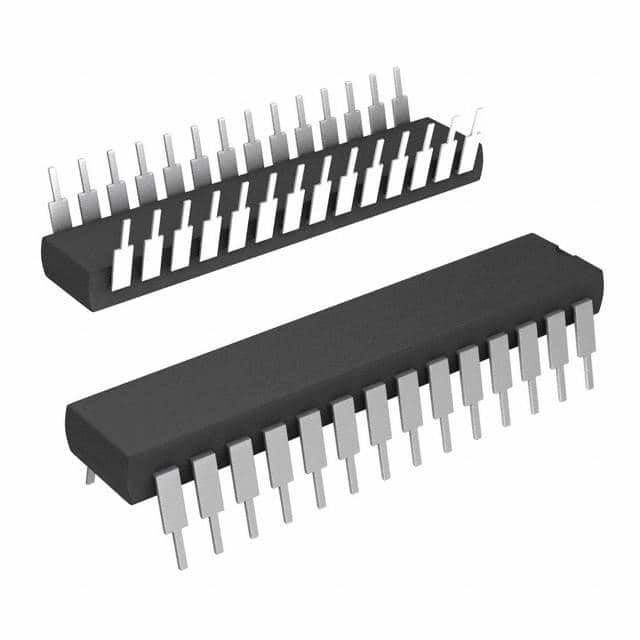Xem thông số kỹ thuật để biết chi tiết sản phẩm.

AT90S2333-8PI
Product Overview
Category
AT90S2333-8PI belongs to the category of microcontrollers.
Use
This microcontroller is commonly used in various electronic applications that require embedded control and processing capabilities.
Characteristics
- Low-power consumption
- High-performance 8-bit RISC architecture
- Flash memory for program storage
- EEPROM for data storage
- In-system programmable
- Wide operating voltage range
- Multiple communication interfaces (UART, SPI, I2C)
- Timers and PWM channels for precise timing control
Package
AT90S2333-8PI is available in a PDIP package, which stands for Plastic Dual Inline Package. This package provides ease of handling and compatibility with standard through-hole soldering techniques.
Essence
The essence of AT90S2333-8PI lies in its ability to provide a compact and versatile solution for controlling and managing various electronic systems.
Packaging/Quantity
AT90S2333-8PI is typically packaged in tubes or trays, with each containing a specific quantity of microcontrollers. The exact packaging and quantity may vary depending on the supplier.
Specifications
- Microcontroller Architecture: 8-bit RISC
- Operating Voltage Range: 2.7V to 5.5V
- Flash Memory: 2KB
- EEPROM: 128 bytes
- RAM: 128 bytes
- Clock Speed: Up to 8 MHz
- Digital I/O Pins: 18
- Analog Input Channels: 4
- Communication Interfaces: UART, SPI, I2C
- Timers/Counters: 2
- PWM Channels: 4
- Operating Temperature Range: -40°C to +85°C
Detailed Pin Configuration
The AT90S2333-8PI microcontroller has a total of 20 pins, each serving a specific purpose. The pin configuration is as follows:
- RESET: Reset Pin
- XTAL1: Crystal Oscillator Input
- XTAL2: Crystal Oscillator Output
- VCC: Supply Voltage
- GND: Ground
- PORTB0: Digital I/O Pin
- PORTB1: Digital I/O Pin
- PORTB2: Digital I/O Pin
- PORTB3: Digital I/O Pin
- PORTB4: Digital I/O Pin
- PORTB5: Digital I/O Pin
- MISO: SPI Master In Slave Out
- MOSI: SPI Master Out Slave In
- SCK: SPI Clock
- SS: SPI Slave Select
- SDA: I2C Data
- SCL: I2C Clock
- ADC0: Analog Input Channel 0
- ADC1: Analog Input Channel 1
- ADC2: Analog Input Channel 2
Functional Features
- In-system programmable allows for easy firmware updates without removing the microcontroller from the circuit.
- Low-power consumption makes it suitable for battery-powered applications.
- Multiple communication interfaces enable seamless integration with other devices and systems.
- Timers and PWM channels provide precise timing control for various applications.
- Compact size and versatile functionality make it ideal for embedded systems.
Advantages and Disadvantages
Advantages
- High-performance 8-bit RISC architecture ensures efficient processing capabilities.
- Flash memory allows for flexible program storage and updates.
- Wide operating voltage range provides compatibility with different power sources.
- Multiple communication interfaces enhance connectivity options.
- In-system programmability simplifies firmware updates.
Disadvantages
- Limited program and data storage capacity compared to higher-end microcontrollers.
- Relatively low clock speed may restrict performance in certain applications.
- Limited number of I/O pins may limit the complexity of projects.
Working Principles
AT90S2333-8PI operates based on the principles of a typical microcontroller. It executes instructions stored in its flash memory, processes data, and interacts with external devices through various communication interfaces. The microcontroller's internal architecture enables it to perform tasks such as data acquisition, processing, and control, making it suitable for a wide range of applications.
Detailed Application Field Plans
AT90S2333-8PI finds applications in various fields, including but not limited to: - Home automation systems - Industrial control systems - Robotics - Automotive electronics - Consumer electronics - Medical devices - Internet of Things (IoT) devices
Detailed and Complete Alternative Models
Some alternative models that offer similar functionality to AT90S2333-8PI include: - ATmega328P - PIC16F877A - STM32F103C8T6 - MSP430G2553 - LPC1768
These alternatives provide comparable features and capabilities, allowing developers to choose the most suitable
Liệt kê 10 câu hỏi và câu trả lời thường gặp liên quan đến ứng dụng AT90S2333-8PI trong giải pháp kỹ thuật
Sure! Here are 10 common questions and answers related to the application of AT90S2333-8PI in technical solutions:
Q: What is the AT90S2333-8PI microcontroller used for? A: The AT90S2333-8PI is a versatile microcontroller commonly used in various technical solutions, including embedded systems, robotics, automation, and control applications.
Q: What is the operating voltage range of the AT90S2333-8PI? A: The AT90S2333-8PI operates within a voltage range of 2.7V to 5.5V.
Q: How much flash memory does the AT90S2333-8PI have? A: The AT90S2333-8PI has 2KB of flash memory for storing program code.
Q: Can I use the AT90S2333-8PI for analog signal processing? A: No, the AT90S2333-8PI does not have built-in analog-to-digital converters (ADCs) or digital-to-analog converters (DACs). For analog signal processing, you may need external components.
Q: Does the AT90S2333-8PI support communication protocols like UART, SPI, and I2C? A: Yes, the AT90S2333-8PI supports UART (Universal Asynchronous Receiver-Transmitter), SPI (Serial Peripheral Interface), and I2C (Inter-Integrated Circuit) communication protocols.
Q: What is the maximum clock frequency of the AT90S2333-8PI? A: The AT90S2333-8PI can operate at a maximum clock frequency of 8 MHz.
Q: Can I use the AT90S2333-8PI for real-time applications? A: Yes, the AT90S2333-8PI can be used for real-time applications by utilizing its built-in timers and interrupts.
Q: How many I/O pins does the AT90S2333-8PI have? A: The AT90S2333-8PI has a total of 18 I/O pins, which can be configured as inputs or outputs.
Q: Is the AT90S2333-8PI programmable in C language? A: Yes, the AT90S2333-8PI can be programmed using C language along with other programming languages like assembly.
Q: Can I use the AT90S2333-8PI in battery-powered applications? A: Yes, the low operating voltage range and power-saving features of the AT90S2333-8PI make it suitable for battery-powered applications.
Please note that these answers are general and may vary depending on specific application requirements and configurations.

